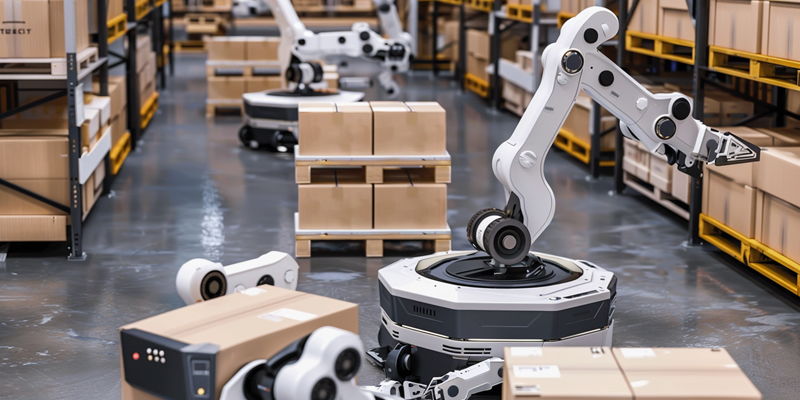Traditional methods of warehouse management, while effective in their time, are being rapidly overshadowed by the march of technological advances. The integration of robotics into warehouse management systems (WMS) is not just an incremental improvement but a complete overhaul of the distribution center ecosystem. This article aims to dissect the old versus the new, weighing traditional warehouse optimization techniques against the disruptive force of automation and robotics. As we delve into the future of warehouse logistics, it becomes clear that the robotic revolution is set to reshape the very foundations of warehouse management systems.
The Traditional Backbone of Warehouse Management
Slotting and Waving in Traditional WMS
In the world of traditional warehouse management, slotting involved the careful placement of items throughout a storage facility to expedite picking processes and reduce travel time. This technique aimed to maximize space utilization and optimize the order fulfillment sequence. Similarly, waving, the process of releasing orders in waves throughout the day, ensured coherent grouping of tasks to keep warehouse associates moving efficiently within the facility. These methods were the lifeblood of a high-functioning warehouse, capitalizing on manual labor and strategic planning.
The Role of WMS and WCS Coordination
For years, Warehouse Management Systems (WMS) have worked seamlessly with Warehouse Control Systems (WCS) to synchronize the flow of goods through storage environments. This coordination was particularly vital in facilities less touched by automation. Here, WMS would be the brains, orchestrating tasks and directing traffic, while WCS would serve as the muscles, carrying out the physical movements prompted by the WMS directives. The interdependency of these two systems formed a structured approach that kept warehouses humming along before the dawn of sophisticated automation.
The Rise of Robotics and Automation in Warehousing
Autonomous Mobile Robots (AMRs) and Human Collaboration
Enter the age of Autonomous Mobile Robots (AMRs), and the warehouse floor began to witness a new dawn of efficiency and productivity. These robotic wonders roam alongside human workers, performing tasks ranging from simple material transportation to complex order picking. In modern facilities powered by robotics, records show practices like each-picking hitting staggering heights, with companies like Locus Robotics facilitating the picking of up to 140,000 units in an hour. The versatility of AMRs extends beyond each-picking to case picking, ensuring adaptability to various warehousing needs and signifying a significant leap in operational efficiency.
The Advent of Warehouse Execution Systems (WES)
Alongside the proliferation of AMRs came the development of Warehouse Execution Systems (WES). This new breed of software bridges the gap between automated and manual warehouse operations, enhancing optimization by directing tasks to both robots and human workers. Companies like Körber have spearheaded the integration of WES into their WMS offerings, creating an operational synergy that boosts overall performance. The blend of WES within traditional systems allows for real-time decision-making and streamlines workflows, propelling warehouse management into the future.
Beyond Traditional Optimization: The Role of Intelligent Mobile Robots
Inventory Control Through Autonomous Robots
As we inch further into the realm of warehousing technology, some robots now act independently of traditional WMS. These ‘intelligent mobile robots’ oversee the inventory within their operational zone, autonomously making decisions that were once the purview of central management systems. They represent a breakthrough in warehouse technology, asserting a level of self-sufficiency that enables them to make adjustments on the fly and react to immediate demands, thus enhancing the overall fluidity of the warehouse’s operations.
The Influence of Robots on Global Optimization
Intelligent mobile robots challenge the long-standing belief that a sophisticated Warehouse Execution System (WES) is necessary for global optimization. These advanced robots illustrate that technology can provide localized, yet substantial, gains in throughput and efficiency, potentially questioning the value proposition of upper-tier WMS solutions. As noted by industry experts like supply chain consultant David Landau, the transformative capabilities of mobile robots necessitate a reevaluation of the market position held by traditional WMS vendors, as these new technologies threaten to eclipse the benefits of standalone WMS.
The Market Dynamics of WMS in the Age of Robots
WMS Vendors and the Inclusion of WES
To remain competitive in an industry increasingly dominated by machines, WMS vendors are embracing WES as the next frontier for market success. The integration of WES enables them to offer a more comprehensive solution that aligns with the productivity advancements brought forth by robotics. This combination is crucial for keeping traditional WMS relevant, as the capabilities and intelligence of robotic systems continue to soar, promising leaps in throughput that could render conventional optimization techniques obsolete.
Competition versus Integration: The Future of Warehouse Optimization
Warehouse management has long relied on proven, traditional approaches. Yet, these methods are quickly becoming antiquated as technological advancements surge ahead, particularly with the introduction of robotics into warehouse management systems (WMS). This evolution isn’t just a minor step forward but represents a fundamental transformation of the warehousing landscape.
In exploring the contrast between the old and the new, we must examine how classic strategies for warehouse optimization stack up against the disruptive emergence of automation and robotics. The leaps in technology are not mere enhancements; they signify a seismic shift in how distribution centers operate.
The movement towards a robotic-centric approach is reshaping warehouse operations, ushering in a future where manual processes are increasingly streamlined by machines. This revolution in warehouse logistics suggests profound changes in the core of warehouse management systems. As robotics continue to infiltrate the warehouse environment, their impact is undeniable, suggesting a future where the efficacy and speed of WMS are dramatically augmented by these intelligent machines. It’s a pivotal time in the industry, where the adoption of robotics signals not just a change, but a complete reinvention of warehouse management practices.

